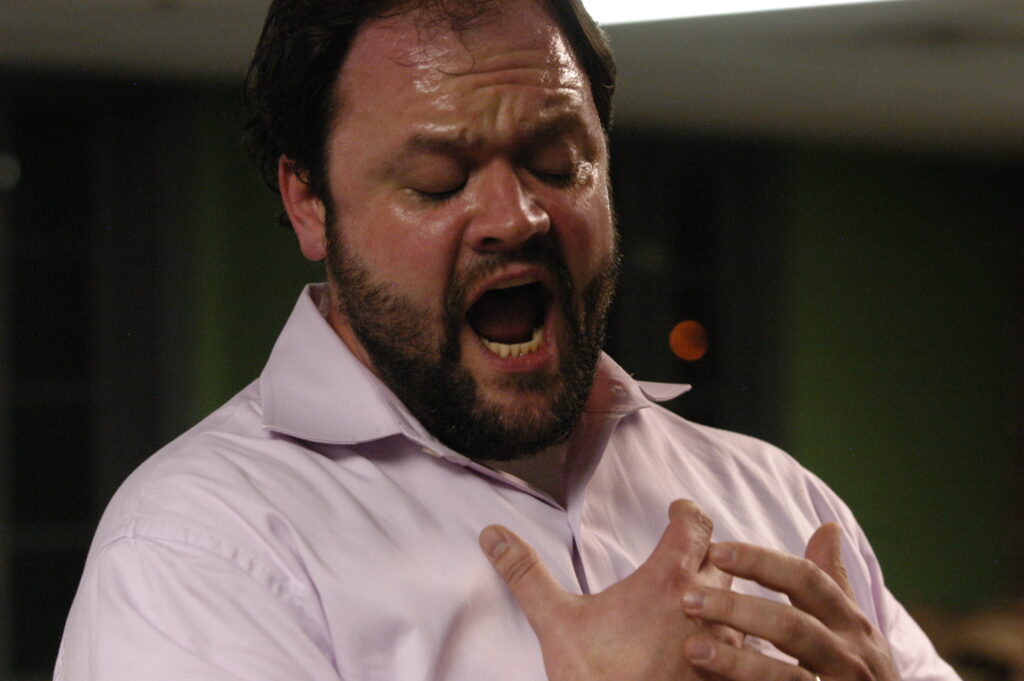In almost all amateur or beginner groups, either the founder or the owner of the most powerful energy for the crowd, or the one who simply can’t play instruments, becomes a yelling mouth. If you want to learn how to sing correctly and not to confuse your vocals with the sounds of defecation, then you need to learn at least the basics of correct voice setting.
These rules apply to academic vocals, after which, in principle, you can sing whatever you want. Even if by nature you have everything and sounds good, and all the muscles are designed by Orpheus himself, classes with a professional will still be very useful.

How to learn to sing: breathing
An important part, one of the basics. Breathing in the vocals is not taken by the chest, but by the entire lower abdomen, and this is an axiom. Air is inhaled only through a nose, you can forget about fast and loud breaths through a mouth. Breathing is held by a diaphragm, and there are two subtle moments. First, it cannot be held relaxed as the sound simply will not be connected to air. Secondly, it cannot be overstressed, because in this case the sound will not connect, but “break away” from the breath, which is clamped by the diaphragm and does not let the voice out.
With a properly placed breathing support, when the air connects to the sound, you will feel a kind of pole, which will go from the throat to the groin area during the next howling. The airflow during singing is also important. For a proper understanding of the principle, I advise you to take a full breath and breathe out the air as slowly as possible. It’s like in a yoga class. With the wrong flow you just can’t finish even two or three lines of text, breathing in oxygen convulsively, as if you were drowned in a basin. In general, to understand how to properly take and hold your breath is one of the easiest, but at the same time the main tasks in the vocals, and this is what you do first.
Get rid of the clamps and open your mouth properly.
The next important task without which it is impossible to learn to sing normally is to remove the clamps of your body, in particular from the neck to the top. Admittedly, there are often exceptions and a person initially sings well without feeling and understanding how exactly he can sing freely. But there are very few such people.
There are several dozens of muscles involved in singing, and each should work in the right mode. If you hear that your singing leaves much to be desired, and at the first lesson they said that there are congestion, then get ready: in the next few months you will have to eliminate them diligently. I almost pinched my throat – the sound is lousy, I didn’t open my mouth to the end – the sound is lousy, my lips are shaking and my chin is clenching – the sound is still lousy!
To sound right, you have to remember one thing: the lower jaw and the entire lower part of the head, including the neck, must be as relaxed as possible, like a sleeping beauty. You should not feel the slightest tension in these areas, because otherwise the sound will be held by these muscles, preventing it from coming out fully. Even when the back of the neck is tense, it affects the sound because it affects all the other muscles.
The lower jaw should simply fall down when singing as we open our mouth with the upper jaw. As soon as you remove all the jaws and completely relax the lower part of the head and neck, you will immediately feel the difference. The sound will fly out quietly, without any obstacles. Some people could not even imagine that they could have such a voice and were genuinely surprised by their new sound. In general, when the sound does not hold and does not stay inside the body, it is able to fly very far, so that in the early morning on a deserted street you can be heard almost from the other side of town.
But there’s more to it than that. When all the jams are removed, the next and most important moment comes.
To open and keep your throat open…
We all have a second mouth. No, not like Alien. I mean, the part of the body where all the food and all the alcohol goes in the first place, and it needs to be learned to feel and control. Opening your mouth properly isn’t gonna help you break up the crowds of young admirers.
Your throat, or second mouth, should work in sync with your regular mouth. And if all you need to do for the latter is to choose the optimal parameters, then the throat you have to open well and keep it open all the time, until the end of your musical career. On the top notes, do it so that the tongue, which hangs in the upper sky, goes up completely when the sound with the air starts to come out of your mouth.
Simply put, you have to pull the upper sky up, while lowering the larynx as well. The easiest example to understand is a yawn. When you yawn, notice how free and wide your throat opens. Now you must learn how to do it without the natural mechanisms of your body. Of course, you don’t have to open your mouth like that on the whole range, but on the top notes you have to feel the so-called pre-yawn.
There’s another example to understand how it feels. If you swallowed some big piece of food that you didn’t fully chew, remember how slowly it went down your throat. That’s about how you should open it. The main thing is to learn not to strain the root of the tongue and the tongue itself. That’s how it’ll close the passage of your other mouth. If your throat is not open enough during the singing, the sound will be weak and dull, heterogeneous.
In addition, you should try to open your throat and sing in a vertical position rather than in a horizontal position for a more collected and resonant sound by raising the curtain of the sky. In order to learn how to do all this, as well as help your muscles adapt more quickly to new work, you can start with the easiest and at the same time very effective way. Try to read all the articles or books in your ears every day while talking with your throat open. Another great training session will be to do the same with patterning.
Heading the sound forward, working with resonators…
Next step: direction of sound forward and to resonators. Depending on the type of voice, you’ll have different advantages in musical ranges. If your type is a tenor, you’ll have a strong top, but a weak chest resonator. If the bass is bass, the chest will respond yay, but the head register will limp. After studying for a few years, of course, you align your voice across your full range. But it’s a hard and routine job that you have to devote time to.

Leaving resonators, as the work with them should be the last, we pay attention to the important thing – the direction of sound. As often happens in the world of vocals, the best method is to feel, visualize and represent. All sound should come out, forward, not stay in you. One of the points for its direction is the place between the roots of the teeth and the upper hard sky.
Direction of sound and stuffing of resonators is a very long and difficult task, if you achieve mastery in it, you can proudly call yourself a model vocalist. Once you’ve mastered these skills, you’ll be left with technical exercises. Since there is no limit to perfection, you can and must do them constantly and infinitely.
Everyone can learn to sing properly. It is important to understand that each person has their own range and voice potential, so you will not necessarily sound like Luciano Pavarotti, but you will most likely be able to learn to sing like Sting. However, without the help of a mentor, it will be difficult to do all this because it is not easy to appreciate yourself.
We just set out the basic principles of proper vocals, but if you want to sound cool and correct, and most importantly, to be a professional, you should go to the teacher. It is desirable to start with academic vocals. Remember that the voice is also an instrument, and to fake on it is even worse than on everything else.